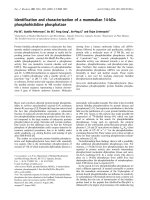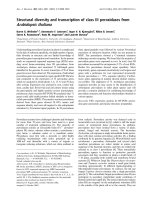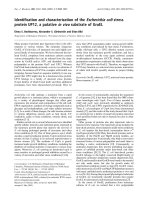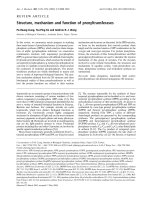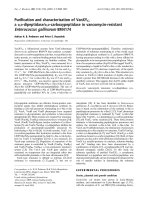Báo cáo y học: "Electroconvulsive therapy and determination of cerebral dominance" pptx
Bạn đang xem bản rút gọn của tài liệu. Xem và tải ngay bản đầy đủ của tài liệu tại đây (229.21 KB, 4 trang )
BioMed Central
Page 1 of 4
(page number not for citation purposes)
Annals of General Hospital
Psychiatry
Open Access
Review
Electroconvulsive therapy and determination of cerebral
dominance
Milan Dragovic
1
, Lindsay Allet
2
and Aleksandar Janca*
2,3
Address:
1
Centre for Clinical Research in Neuropsychiatry, Graylands Hospital, Perth, Australia,
2
Inner City Mental Health Service, Royal Perth
Hospital, Perth, Australia and
3
School of Psychiatry and Clinical Neurosciences, University of Western Australia, Perth, Australia
Email: Milan Dragovic - ; Lindsay Allet - ; Aleksandar Janca* -
* Corresponding author
Abstract
Electroconvulsive therapy (ECT) often results in a number of short- and long-time side effects
including memory impairment for past and current events, which can last for several months after
ECT treatment. It has been suggested that unilateral ECT (uECT) with electrodes placed over the
non-dominant (typically right) hemisphere significantly reduces side effects, especially memory
disturbances. It is important to note that cerebral dominance equates to speech dominance and
avoiding this area of the brain also reduces speech dysfunction after ECT. Traditionally, the routine
clinical determination of cerebral dominance has been through the assessment of hand, foot and
eye dominance, which is an easy and inexpensive approach that, however, does not ensure
accuracy. This review of literature on different methods and techniques for determination of
cerebral dominance and provides evidence that functional transcranial Doppler sonography (fTCD)
represents a valid and safe alternative to invasive techniques for identifying speech lateralisation. It
can be concluded that fTCD, notwithstanding its costs, could be used as a standard procedure prior
to uECT treatment to determine cerebral dominance, thereby further reducing cognitive side-
effects of ECT and possibly making it more acceptable to both patients and clinicians.
Introduction
Electroconvulsive therapy (ECT) is often regarded by the
general public as a controversial procedure for the treat-
ment of mental disorders. This is despite evidence of its
safety and efficacy [1], and its benefit over anti-depres-
sants in patients resistant to conventional medications
and those with life threatening conditions such as catato-
nia and depressive stupor. The evidence suggests that in
unipolar depression ECT has better efficacy when com-
pared with older tricyclic antidepressants and monoam-
ine oxidase inhibitors, as well as newer drugs such as
paroxetine [2]. Notwithstanding the efficacy of ECT, its
use is declining in some countries [3], while in a few oth-
ers, including Italy – where ECT was first introduced in
1938 by Cerletti and Bini – it is prohibited. Aside from
political reasons and public pressure, the declining trend
in ECT use could be the result of the introduction of more
effective antidepressants.
A further possible explanation for the reduction in ECT
use may relate to the concern over adverse effects of the
procedure. There are a number of short-term side effects
including headache, nausea and, sometimes, brief confu-
sion. However, the main side effect of concern is memory
impairment for past events (retrograde amnesia) and for
current events (anterograde amnesia) that can last for sev-
eral months after a course of ECT treatment. Some of these
side effects are substantially reduced by advances in safety
Published: 12 August 2004
Annals of General Hospital Psychiatry 2004, 3:14 doi:10.1186/1475-2832-3-14
Received: 30 June 2004
Accepted: 12 August 2004
This article is available from: />© 2004 Dragovic et al; licensee BioMed Central Ltd.
This is an open-access article distributed under the terms of the Creative Commons Attribution License ( />),
which permits unrestricted use, distribution, and reproduction in any medium, provided the original work is properly cited.
Annals of General Hospital Psychiatry 2004, 3:14 />Page 2 of 4
(page number not for citation purposes)
and the introduction of controlled-current ECT machines.
The utilisation of muscle relaxants, anaesthetics and resus-
citation equipment, and electroencephalographic moni-
toring during the application of ECT are considered now
considered routine. In addition, ECT guidelines issued by
the UK National Institute for Clinical Excellence [4]
restrict the use of ECT only to patients with severe symp-
toms to which "an adequate trial of other treatment
options has proven ineffective" (p. 5). The risk associated
with ECT has also been reduced with the introduction of
refined ECT procedures, such as "maintenance ECT" or
"unilateral ECT" (uECT) [5].
It has been suggested that unilateral treatment signifi-
cantly reduces side effects, especially memory distur-
bances [6,7]. Despite the well-documented efficacy of
unilateral over bilateral ECT, current practice still favours
bilateral treatments [8,9]. Unilateral treatment, for the
majority of patients, entails that electrodes are placed over
the non-dominant, right hemisphere. Given that memory
impairment could be reduced by unilateral electrode
placement and the fact that placement of electrodes to the
dominant hemisphere may cause a greater disturbance in
memory compared to non-dominant uECT, determina-
tion of cerebral dominance appears to be critical [10]. It is
important to note that cerebral dominance here equates
to speech dominance, including a lateralised capacity of
the cortex to be the locus of language-specific memory
traces [11]. Avoiding the stimulation of the speech area
will therefore reduce speech dysfunction after ECT. Tradi-
tionally, the routine clinical determination of cerebral
dominance has been through the assessment of hand,
foot and eye dominance. It certainly is an easy and inex-
pensive approach, but it does not ensure accuracy.
Unilateral ECT and cerebral dominance
The practice of determining cerebral dominance from
handedness appears to mirror Broca's view that a person's
handedness is opposite to hemispheric language speciali-
sation. This, however, is incorrect, since there is no "mir-
ror-image" cortical language organisation in left-handers.
Several attempts to improve cerebral dominance assess-
ment by introducing additional clues such as handwriting
posture (i.e. inverted or hooked style versus non-inverted)
and familial sinistrality have not substantially improved
the prediction as to determination of cerebral dominance
[12,13]. For example, the use of hand writing posture to
determine speech dominance has been shown to be com-
pletely invalid [14-16].
A great majority of left-handers have also an ipsilateral
functional specialisation for language (i.e. left hemi-
spheric, as in the majority of right-handers). Although
right-handers are more clearly lateralised than left-hand-
ers in this regard, a certain proportion of right-handers
have language localised in the right-hemisphere. This has
been confirmed by various techniques, ranging from the
old and invasive procedures such as the intracarotid
sodium amytal test and ECT, to the new and more sophis-
ticated techniques such as functional magnetic resonance
imaging (fMRI) and functional transcranial Doppler
sonography (fTCD). The pooling of empirical data from a
number of studies [17-27] which used both old and new,
non-invasive techniques to determine cerebral domi-
nance for language is shown in Table 1.
From Table 1 one can see that if the hemisphere for uECT
treatment were solely ascertained from handedness
assessment, then a small proportion of right-handers and
a much larger proportion of left-handers would have
treatment administered to the dominant hemisphere.
One could also see from it that about 3% of right-handers
and 25% of left-handers have speech localised in the right
hemisphere. This represents the error rate percentage in
both groups if uECT was administered to all patients on
the right side of the cranium. However, the overall error
rate is lower since the incidence of left-handedness is low,
and is likely to be in the range of 6.4% to 12.5% [28]. A
strict application of the "mirror-image" cortical organisa-
tion (i.e. considering left-handers as right-hemisphere
dominant and therefore performing left-sided uECT) is
even more destructive, illogical, and would increase the
error rate. For example, in the survey of the use of ECT by
psychiatrists in New Zealand [9], 20% of respondents
reported using uECT depending on handedness. Adverse
effects caused by determining speech dominance on the
basis of handedness would be lower if right-sided ECT was
always administered, thus making handedness assess-
ment unnecessary. Given the additional risk of uECT treat-
ment on the dominant hemisphere, which is even more
disruptive than bilateral ECT [29], correct identification of
cerebral dominance appears to be crucial. The importance
of identification of cerebral dominance prior to electrode
placement has been highlighted by a number of authors
[6,10,28], but routine ECT practice has remained
unchanged.
From intracarotid injection to transcranial
sonography
Until recently, an accurate determination of speech dom-
inance prior to a course of ECT treatment was possible
only through invasive procedures such as intracarotid
sodium amytal test [30], also known as the Wada tests,
and through the administration of ECT itself – the ECT
Test [10]. Lateralisation of language capacity using the
Wada test is based on the temporary anaesthesia of one
half of the brain. The subject in the study receives sodium
amytal – a short-acting anaesthetic – into (usually) the left
carotid artery. This causes the left hemisphere to be tem-
porarily rendered dysfunctional. As a result, if this were
Annals of General Hospital Psychiatry 2004, 3:14 />Page 3 of 4
(page number not for citation purposes)
the patient's dominant hemisphere, the subject's language
capacity – primarily speech production – is affected. Con-
versely, injecting sodium amytal into the right carotid
artery leaves this language capacity intact. By using this
technique it is possible to identify precisely which hemi-
sphere hosts language, which is considered necessary for
patients who are to go through neurosurgical procedures.
Although accurate, the use of Wada procedure in a normal
healthy population is generally considered as unsuitable.
Using ECT for the determination of cerebral dominance
is, as mentioned previously, associated with adverse
effects and therefore may not be entirely appropriate,
although Weiner [31] suggests giving left and right side
ECT alternately followed by the administration of a sim-
ple verbal performance test and then continuing treat-
ment with the side associated with the better result.
The advent of sophisticated and non-invasive technolo-
gies during the 1980s and 1990s has enabled a non-inva-
sive approach to the assessment of speech dominance.
One of the most elegant, mobile, and cost effective meth-
ods for determining cerebral dominance for speech is
functional transcranial Doppler sonography (fTCD).
fTCD is increasingly used in both clinical and research set-
tings and is a new and robust technique based on the
same principles as fMRI. Subjects in studies using this
method are asked to generate as many possible words
within 5-second periods after a letter presented on the
computer screen cues for word generation. Basically, fTCD
measures cerebral blood flow velocity which corresponds
to brain activity. The physical foundation for this tech-
nique is quite old and is based on the work of the Austrian
mathematician and physicist, Christian Doppler (1803–
1853), who discovered that the change in pitch results
from a shift in the frequency of the sound waves. This
means that the speed of a physical object (i.e. blood) can
be estimated by measuring the rate of change of pitch. To
complete the fTCD procedure, the additional sound pro-
duced through the arteries is required.
Recently, it has been argued that fTCD can reliably replace
the Wada procedure in patients undergoing brain surgery
[32]. The validity of fTCD has been established by com-
paring fTCD with the Wada test, which is considered as
the ultimate (gold standard) test of cerebral lateralisation
for speech. Several independent studies [33-35] have
found highly significant correlations between these two
methods. A high agreement between fTCD and fMRI has
also been identified [36] for the assessment of cerebral
speech lateralisation.
Conclusion
This review of the literature on ECT and cerebral domi-
nance provides evidence that fTCD represents a valid and
safe alternative to invasive techniques for identifying
speech lateralisation. It seems therefore, that fTCD, not-
withstanding costs, could be used as a standard procedure
prior to uECT treatment to determine cerebral domi-
nance, thereby further reducing cognitive side-effects of
ECT and possibly making it more acceptable to both
patients and clinicians.
Competing interests
none declared.
Table 1: Percentages of right- and left-handers with speech localised predominantly in the left, right hemisphere, or bilaterally,
according to different studies and techniques
Study Right-handers Left-handers
Left Bilateral Right Left Bilateral Right
Milner, 1975* 96 0 4 70 15 15
Rossi & Rosadini, 1967* 99 1 0 40 10 50
Pratt & Warrington, 1972
#
9901 - - -
Warrington & Pratt, 1973
#
70723
Geffen et al., 1978
#
920867033
Geffen & Traub, 1979
‡
8497611524
Springer et al. 1999
&
9460 - - -
Pujol et al. 1999
&
9640761410
Szaflarski et al. 2002
&
78148
Hund-Georgiadis et al. 2002
&
9406471241
Knecht et al. 2000
†
4 27
* intracarotid sodium amytal test
#
ECT
‡
dichotic listening test
&
fMRI
†
fTCD
Publish with BioMed Central and every
scientist can read your work free of charge
"BioMed Central will be the most significant development for
disseminating the results of biomedical research in our lifetime."
Sir Paul Nurse, Cancer Research UK
Your research papers will be:
available free of charge to the entire biomedical community
peer reviewed and published immediately upon acceptance
cited in PubMed and archived on PubMed Central
yours — you keep the copyright
Submit your manuscript here:
/>BioMedcentral
Annals of General Hospital Psychiatry 2004, 3:14 />Page 4 of 4
(page number not for citation purposes)
References
1. American Psychiatric Association: The practice of electroconvul-
sive therapy: Recommendations for treatment, training, and
privileging: A task force report of the American Psychiatric
Association. Washington DC: American Psychiatric Association 1990.
2. Folkerts HW, Michael N, Tolle R: Electroconvulsive therapy vs
paroxetine in treatment resistant depression – a randomised
study. Acta Psychiatr Scand 1977, 96:334-342.
3. Savithasri VE, McLoughlin DM: Electroconvulsive therapy – state
of the art. Brit J Psychiat 2003, 182:8-9.
4. National Institute for Clinical Excellence: Guidance on the use of
electroconvulsive therapy. London: National Institute for Clinical
Excellence 2003.
5. Wijeratne C, Halliday GS, Lyndon RW: The present status of elec-
troconvulsive therapy: A systematic review. Med J Australia
1999, 171:250-254.
6. Zamora EN, Kaelbling R: Memory and electroconvulsive
therapy. Am J Psychiatry 1965, 122:546-554.
7. Fleminger JJ, Horne DJ, Nair NPV, Nott PN: Differential effect of
unilateral and bilateral ECT. Am J Psychiatry 1970, 127:430-436.
8. Sackeim HA, Prudic J, Devanand DP, et al.: A prospective, rand-
omized, double-blind comparison of bilateral and unilateral
electroconvulsive therapy at different stimulus intensities.
Arch Gen Psychiat 2000, 57:425-434.
9. Strachan JA: Electroconvulsive therapy – attitudes and prac-
tice in New Zealand. Psychiatric Bulletin 2001, 25:467-470.
10. Pratt RTC, Warrington EK, Halliday AM: Unilateral ECT as a test
for cerebral dominance, with a strategy for treating left-
handers. Brit J Psychiat 1971, 119:79-83.
11. Näätänen R, Lehtokoski A, Lennes M, Chenour M, Huotllainen M,
Ilmoniemi RJ, Luuk A, Allik J, Sinkkonen J, Alho K: Language specific
phoneme representations revealed by electric and magnetic
brain responses. Nature 1997, 385:432-434.
12. Freeman CPL: Electroconvulsive therapy: Its current clinical
use. Brit J Hosp Med 1979, 21:281-292.
13. Allen GS: Letter: Language lateralisation and unilateral ECT.
Brit J Psychiat 1980, 136:316.
14. Warrington EK, Pratt RT: The significance of laterality effects. J
Neurol Neurosurg Psychiatry 1981, 44:193-196.
15. McKeveer WF, Van Deventer AD: Inverted handwriting posi-
tion, language laterality, and the Levy-Nagylaki model of
handedness and cerebral organisation. Neuropsychologia 1980,
18:99-102.
16. Beaumont JG, McCarthy R: Dichotic ear asymmetry and writing
posture. Neuropsychologia 1981, 19:469-472.
17. Milner B: Psychological aspects of focal epilepsy and its neuro-
surgical managament. In: Advances in Neurology Volume 8. Edited
by: Purpura DP, Penry JK, Walters RD. New York: Raven; 1975.
18. Rossi GF, Rosadini G: Experimental analysis of cerebral domi-
nance in men. In: Brain mechanisms underlying speech and language
Edited by: Millikan CH, Darley FL. New York: Grune.
19. Pratt RTC, Warrington EK: The assessment of cerebral domi-
nance with unilateral ECT. Brit J Psychiat 1972, 121:327-328.
20. Warrington EK, Pratt RT: Language laterality in left handers
assessed by unilateral ECT. Neuropsychologia 1973, 11:423-428.
21. Geffen G, Traub E, Stierman I: Language laterality assessed by
unilateral ECT and dichotic monitoring. J Neurol Neurosurg
Psychiatry 1978, 41:354-360.
22. Geffen G, Traub E: Preferred hand and familial sinistrality in
dichotic monitoring. Neuropsychologia 1979, 17:527-532.
23. Springer JA, Binder JR, Hammeke TA, Swanson SJ, Frost JA, Bellgowan
PS, Brewer CC, Perry HM, Morris GL, Mueller WM: Language
dominance in neurologically normal and epilepsy subjects: A
functional MRI study. Brain 1999, 122:2033-2045.
24. Pujol JDJ, Losilla J, Capdevila A: Cerebral lateralization of lan-
guage in normal left-handed people studied by functional
MRI. Neurology 1999, 52(5):1038-1043.
25. Szaflarski JP, Binder JR, Possing ET, McKiernan KA, Ward BD, Ham-
meke TA: Language lateralization in left-handed and ambi-
dextrous people: fMRI data. Neurology 2002, 59(2):238-244.
26. Hund-Georgiadis M, Lex U, Friederici AD, von Cramon DY: Non-
invasive regime for language lateralization in right- and left-
handers by means of functional MRI and dichotic listening.
Exp Brain Res 2002, 145(2):166-176.
27. Knecht SDB, Deppe M, Bobe L, Lohmann H, Flöel A, Ringelstein EB,
Henningsen H: Handedness and hemispheric language domi-
nance in healthy humans. Brain 2000, 123:2512-2518.
28. Kopelman MD: Speech dominance, handedness and electro-
convulsions. Psychol Med 1982, 12:667-670.
29. Halliday AM, Davison K, Browne MW, Kreeger LC: A comparison
of the effects on depression and memory of bilateral ECT
and unilateral ECT to the dominant and non-dominant
hemispheres. Brit J Psychiat 1968, 114:997-1012.
30. Wada J, Rasmussen T: Intracarotid injection of sodium amytal
for the lateralisation of sebrebral speech dominance. J
Neurosurg 1960, 17:266-282.
31. Weiner RD: The psychiatric use of electrically induced
seizures. Am J Psychiatry 1978, 136:1507-1517.
32. Deppe M, Ringelstein EB, Knecht S: The investigation of func-
tional brain lateralization by transcranial Doppler
sonography. Neuroimage 2004, 21(3):1124-1146.
33. Knecht S, Deppe M, Ebner A, Henningsen H, Huber T, Jokeit H, Rin-
gelstein EB: Noninvasive determination of language lateraliza-
tion by functional transcranial Doppler Sonography: A
comparison with the Wada test. Stroke 1998, 29:82-86.
34. Rihs F, Sturzenegger M, Gutbrod K, Schroth G, Mattle HP: Determi-
nation of language dominance: Wada test confirms func-
tional transcranial Doppler sonography. Neurology 1999,
52(8):1591-1596.
35. Knake S, Haag A, Hamer HM, Dittmer C, Bien S, Oertel WH, Rose-
now F: Language lateralisation in patients with temporal lobe
epilepsy: A comparison of functional transcranial Doppler
sonography and the Wada test. Neuroimage 2003,
19(3):1228-1232.
36. Deppe M, Knecht S, Papke K, Lohmann H, Fleischer H, Heindel W,
Ringelstein EB, Henningsen H: Functional MRI measurement of
language lateralisation in Wada- tested patients. J Cereb Blood
Flow Metab 2000, 20(2):263-268.
